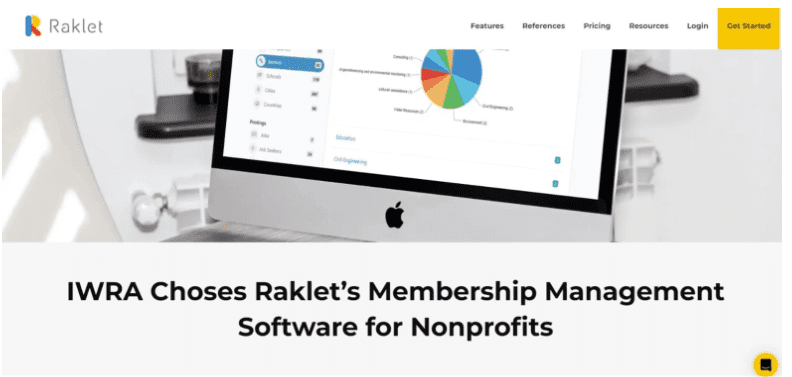Do you volunteer for a good cause? Do you understand the board of directors’ nonprofit role in developing your company? We’ll tell you about the basics of the nonprofit board of directors, the nonprofit board structure, the nonprofit organization board of directors program, how many board members have jobs, how to sign up for service, and why a charity needs a well-organized board. Everything you need to know about a nonprofit board of directors’ responsibilities will be covered in this article. Raklet, which has nonprofit management software, will also highlight its benefits for improving nonprofit board of directors processes.

What Is a Nonprofit Board of Directors?
A nonprofit board of directors for a nonprofit organization is a group of people who are in charge of running and managing the organization. Most of the time, the board is made up of volunteers who were elected or appointed to their roles. The board is in charge of making decisions that are good for the organization and making sure that it is fulfilling its goal and helping its members well.
The exact job of a board of directors for nonprofit will depend on the size and mission of the group. In general, the board is in charge of setting the overall strategy and direction of the organization, keeping an eye on its finances, hiring and reviewing the executive director, and making sure the organization follows all laws and rules. The board may also be active in fundraising, reaching out to the community, and advocating for the organization’s mission. The board is responsible to the people who have an interest in the group, such as donors, members, and the general public.

What Does a Nonprofit Board Do?
A nonprofit organization board of directors is responsible for several different things. Major operations are:
- Defining the goals, values, and objectives of the company
- Endorsing the organization’s financial plan and checking if it’s being followed
- Appointing an executive director and monitoring their work
- Making sure the company complies with all rules and regulations.
- Taking charge of the organization’s investments and fundraising efforts
- Creating operational guidelines through the formulation of policies and procedures
- Risk analysis and administration
- Developing ties with interested parties such as funders, volunteers, and locals
The Importance of Nonprofit Boards
A nonprofit organization’s assets can only function effectively with the right nonprofit board structure in place to provide proper financial oversight and complete control. A well-organized nonprofit board structure requires competent and efficient management. It gives a legal voice, a framework for decision-making and proper financial oversight, and establishes clear lines of authority, positions, and obligations for board members. A nonprofit board benefits from having members with a wide range of backgrounds, experiences, and opinions. It is important to pick board members who are both knowledgeable and willing to devote significant time and energy to the organization’s mission.
The following roles make up the majority of potential board members chief executive, board president, and staff members of a typical nonprofit organization:
- Chairperson
- Vice-chairperson
- Treasurer
- Secretary
- Officers and heads of applicable committees
The chairperson is aware of the nonprofit board responsibilities and makes sure the organization is successful in achieving its goals. The vice-chairman is the board chair’s right-hand man and takes charge of business affairs while the chair is absent. The treasurer is responsible for the bank accounts, monitoring the organization’s finances, and making sure the allocated funds are being used wisely. The secretary is accountable for keeping detailed records of meeting agendas and documenting all board meetings. Fundraising and community engagement are only two examples of the kinds of tasks that can be delegated to committee chairs, board members, and executives.
How Do You Get on a Board of Directors?
There are a few ways to go about getting on the nonprofit board of directors of a charity. Here are the steps:
- Find the charities that capture your attention and learn all you can about them.
Finding a board of directors for nonprofit whose mission and beliefs are a good fit for you is the first step in becoming a board member. Try to find groups where you can make a real difference and where the goals and values of the group’s members match your own. Understanding the nonprofit organization board of directors’ strong goals will help you decide if you’re a good fit for the board members.
- Make connections with people who are already active in nonprofits.
On the board of directors for nonprofit organizations, networking your personal and professional networks is a vital skill. Also, they may be a wonderful way to recruit new members for the entire board and find out about new opportunities. Try to meet people who are already involved in nonprofits by going to events and conferences geared toward that area. Express your interest in joining the activities of that board of directors for nonprofits and ask them about their time spent working in the field.
- Learn more about the nonprofit industry by participating in local and national events.
Participating actively in related events, meetings, and conferences is a fantastic way to gain insight into the nonprofit organization board of directors and the issues that organizations are addressing. It’s in the best interest of the nonprofit board of directors for you to find and attend board meetings that are related to your interests. This will also help you keep up with what’s going on in your field. So, attending one of these gatherings can help you learn more about the industry.
- Gain valuable skills and make connections by volunteering with a non-profit.
The best approach to making connections in the nonprofit world is to volunteer with one. You should seek volunteer opportunities with groups that share your ideals and interests and that can put your unique set of abilities to good use. Volunteering is a great way to find out about an organization’s finances and the problems it tries to solve. It also helps you connect with the organization’s goal, leadership team, employees, board members, and the larger volunteer community.
- Reach out to groups whose missions and goals you believe in and ask if you can join their board of directors.
You should show interest in joining a board and being a part of it if you’ve found organizations that share your views and interests and have worked in the field for a while. Make contact with groups that interest you and tell them you want to join their board of directors. Get ready to talk to possible board members about your background, qualifications, and why you care so much about the organization’s cause.
6 Nonprofit Board Positions
There are a number of places on the board committees of the National Council of Board of Directors that are important for the success of the board members. Here are the six most important ones:
- The chair or president of the board of directors is in charge of the board members and ensures it functions properly. They usually act as meeting leaders, establishing agendas, and coordinating strategy development with the company’s top executives.
- The vice chair or vice president assists the chair in carrying out their tasks and fills in for the chair in their absence. Depending on the situation, they may also take on additional tasks.
- The treasurer’s job is to keep an eye on the nonprofit organization’s cash flow. Making and sticking to a budget, accurate financial reporting, and close collaboration with the company’s top executive all contribute to this goal.
- The secretary is in charge of the nonprofit organization’s records and keeping accurate minutes of all meetings. They may also be responsible for writing and talking to nonprofit board members, workers, and outside participants.
- “At-large members” are the board members who can’t vote but bring a wide range of experiences and ideas. They can take on different jobs and responsibilities as needed.
- The nonprofit organization’s board of directors appoints members to the committees they create, and these individuals may include other board members or interested parties from outside the organization.

10 Key Responsibilities for Nonprofit Board of Directors
Serving on the board of directors of the organization is a huge commitment of time and energy. Here are the ten nonprofit board responsibilities:
- Governance: The nonprofit boards are accountable for the organization’s governance and the enforcement of all applicable laws and regulations.
- Strategy: The board of directors of a nonprofit and the chief executive officer or executive director work together to create and carry out the organization’s long-term strategic plan.
- Financial Oversight: The nonprofit boards are accountable for managing the organization’s budget, supervising its spending, and guaranteeing accurate financial reporting.
- Fundraising: The board must raise money to ensure the organization has what it needs to carry out its goal. Soliciting money from external parties and putting together fundraising initiatives are two possible ways to accomplish this.
- Risk Management: The board must manage the organization’s exposure to potential threats, such as those to its finances, legal standing, and good name.
- Oversight of Programs and Services: The board is responsible for overseeing the organization’s programs and services to ensure they are consistent with the organization’s mission and help achieve its stated objectives.
- Human Resources: The board is accountable for managing all aspects of the company’s human resources, such as recruitment, evaluation, and compensation.
- Community Relations: The board must keep up friendly contact with the board members, including donors, volunteers, and other interested parties.
- Board Development: Recruiting and training new board members is the board’s responsibility, as is making sure current board members have the expertise they need to do their jobs.
- Evaluation: The board must regularly assess its own and the organization’s performance and make any required adjustments based on the findings.

How To Become a Board Member of a Nonprofit: 5 Steps
While serving on the board of executive directors of a nonprofit organization may be a highly gratifying and meaningful experience for many organizations, prospective nonprofit board executive director members should be aware of the commitments and expectations that come with the position. Listed below are the five requisites for being a nonprofit’s board executive director member:
- Find a nonprofit to support. Do some preliminary research to find a nonprofit that shares your values and interests. Check out groups that are having a constructive effect on the neighborhood, and that mean something. Examine their online presence to discover more about their operations and management.
- Once you’ve narrowed your focus to a handful of organizations, it’s time to start attending board meetings to learn more about how they function and the role board members play. In order to better serve the community, several non-profits welcome guests or allow anyone to attend their open meetings.
- One approach is to meet the staff, volunteers, and current board members to establish rapport. Make contact with the group and tell them you want to join in. As a new board member, you should participate in the organization’s social and fundraising activities to get to know people and the culture around you.
- Donate your knowledge. Nonprofits rely on a wide variety of volunteers and board members with a variety of expertise and experience. Identify your abilities and contributions to the company. Expertise in any field, from law and finance to event planning and fundraising, is applicable.
- After getting to know the organization and expressing an interest in becoming a board member, you should submit your application. Submitting a resume or CV and a cover letter detailing your interest in the nonprofit and your qualifications for the board post is standard practice for most organizations.
Raklet – Nonprofit Management Software
Do you need some help with nonprofit sponsorship or nonprofit CRM software? You’re at the right address. Nonprofits can benefit from Raklet’s suite of products since they simplify administrative tasks, recruit members, provide financial oversight, and increase board member participation. Raklet’s event planning, fundraising, financial statements, and membership management tools may reduce administrative burdens on board members and double the positive effects of charitable organizations.

The nonprofit structure and nonprofit board responsibilities are very important for the board of directors, and CRM software is just as important too. IPCEF has experienced nonprofit CRM software for all its needs with the help of Raklet, and you can click on Raklet’s blog to see what you can do with Raklet’s help.
Top Benefits of Nonprofit Association Management Software
There are many ways in which small nonprofits might also benefit from using association management software.
- Streamlining processes and cutting down on paperwork
- Enhancing Participation and Interaction Board Member
- Improving donor management and fundraising
- Giving users access to analytics and data in real-time so they can make better choices
- Improving productivity and precision through process automation.
How to Start a Nonprofit: 8 Steps to Get Started
It’s not easy to start a nonprofit, but if you put in the time, resources, and effort, you’ll be rewarded with a better world. For anyone interested in launching a nonprofit, here are the first eight steps to follow:
- Research your mission and vision: The first order of business is to investigate and articulate the organization’s ultimate goal. All of your subsequent actions and choices will be based on this.
- Form a board of directors: A board of directors for a nonprofit is a group of people appointed by the organization’s members to oversee the organization’s operations and make major decisions. Select team members who are invested in the company’s future and share your vision.
- Incorporate your organization: To obtain tax-exempt status and enjoy the benefits of limited liability, you need to incorporate your business.
- File for tax-exempt status: You must apply to the Internal Revenue Service (IRS) for tax-exempt status.
- Create a fundraising strategy: The money raised will go a long way toward helping your nonprofit organization run smoothly and accomplish its goals. Create a plan that incorporates multiple methods of generating financial support.
- Hire staff or recruit volunteers: Depending on the scale and complexity of your organization, you may need to fill positions on staff or enlist the help of volunteers in order to run smoothly.
- Create policies and procedures: Document the rules and regulations that will be followed in your business.
- Launch your organization: Launch your company and get to work once you’ve finished the preceding procedures.
Last Words On Board of Directors Nonprofit
We understand, as a non-profit, the value of an efficient and competent board of directors. Our board is crucial in setting the direction for our organization, keeping us committed to our mission and values, and helping us make the tough choices necessary to succeed. We have great faith in our board’s ability to continue making a difference in the future, and we are grateful for all they have accomplished thus far.
Our board’s dedication to working as a unit is the driving force behind our organization’s success. Our board members’ thoughts and input are valued, and we work closely with our executive director and staff to ensure that everyone is on the same page with regard to our collective goals. And we’re always on the lookout for new board members who share our commitment to social justice.
Attending a board meeting is the first step toward joining the board, so we hope you’ll take that step soon. You may observe our board in action and gain insight into the vital role we play. And if you do join us, we’ll make sure you have all you need to do well in your new position. Our nonprofit management software has helped us streamline our operations and keep us organized, allowing us to devote more time and energy to the things that truly matter: the people we serve.







